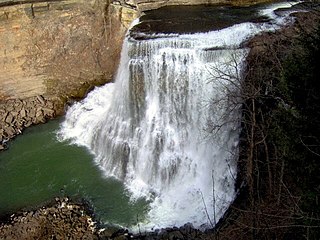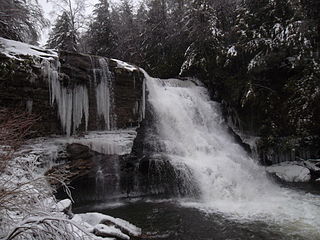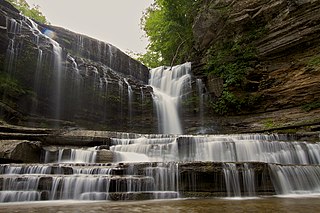Related Research Articles

Protected areas of South Australia consists of protected areas located within South Australia and its immediate onshore waters and which are managed by South Australian Government agencies. As of March 2018, South Australia contains 359 separate protected areas declared under the National Parks and Wildlife Act 1972, the Crown Land Management Act 2009 and the Wilderness Protection Act 1992 which have a total land area of 211,387.48 km2 (81,617.16 sq mi) or 21.5% of the state's area.
Protected areas of Tasmania consists of protected areas located within Tasmania and its immediate onshore waters, including Macquarie Island. It includes areas of crown land managed by Tasmanian Government agencies as well as private reserves. As of 2016, 52% of Tasmania's land area has some form of reservation classification, the majority is managed by the Tasmania Parks & Wildlife Service. Marine protected areas cover about 7.9% of state waters.

Burgess Falls State Park is a state park and state natural area in Putnam County and White County, Tennessee, located in the southeastern United States. The park is situated around a steep gorge in which the Falling Water River drops 250 feet (76 m) in elevation in less than a mile, culminating in a 136-foot (41 m) cataract waterfall.

The Trustees of Reservations is a non-profit land conservation and historic preservation organization dedicated to preserving natural and historical places in the Commonwealth of Massachusetts. It is the oldest land conservation nonprofit organization of its kind in the world and has 140,000 dues-paying members as of 2018. In addition to land stewardship, the organization is also active in conservation partnerships, community supported agriculture (CSA), environmental and conservation education, community preservation and development, and green building. The Trustees of Reservations own title to 116 properties on 27,000 acres (11,000 ha) in Massachusetts, all of which are open to the public; it maintains conservation restrictions on over 200 additional properties. Properties include historic mansions, estates, and gardens; woodland preserves; waterfalls; mountain peaks; wetlands and riverways; coastal bluffs, beaches, and barrier islands; farmland and CSA projects; and archaeological sites.
Headquartered in Memphis, Tennessee, the Wolf River Conservancy (WRC) is a non-profit 501(c)(3) organization whose stated purpose is "conserving and enhancing the Wolf River and its environs as a natural resource for public education and low-impact recreational activities." It has approximately 1,500 members from throughout West Tennessee, led by an active Board of Directors and staff and advised by the Wolf River Conservancy Trustees. It is a fully accredited member of The Land Trust Alliance.

Swallow Falls State Park is a public recreation area located on the west bank of the Youghiogheny River nine miles (14 km) northwest of Oakland in Garrett County, Maryland, in the United States. The state park features Maryland's highest free-falling waterfall, the 53-foot (16 m) Muddy Creek Falls, as well as smaller waterfalls on the Youghiogheny River and Tolivar Creek. The park is notable for its stand of old hemlock trees, some more than 300 years old, "the last stand of its kind in Maryland."
Natural Lands is a non-profit land conservation organization with headquarters in Media, Pennsylvania, dedicated to the management, protection, and conservation of eastern Pennsylvania and southern New Jersey's native forests, fields, steams, and wetlands. The organization owns and manages 44 nature preserves—totaling more than 23,000 acres—located in 13 counties in Pennsylvania and New Jersey. Nineteen of the preserves are open to the public for recreational use; the others have limited visitation due to the presence of sensitive ecosystems or limited facilities.

South Cumberland State Park is a state park in the middle and southeast portions of Tennessee on the Cumberland Plateau.
The Trust for Public Land is a U.S. nonprofit organization with a mission to "create parks and protect land for people, ensuring healthy, livable communities for generations to come." Since its founding in 1972, The Trust for Public Land has completed 5,000 park-creation and land conservation projects across the United States, protected over 3 million acres, and helped pass more than 500 ballot measures—creating $70 billion in voter-approved public funding for parks and open spaces. The Trust for Public Land also researches and publishes authoritative data about parks, open space, conservation finance, and urban climate change adaptation. Headquartered in San Francisco, the organization is among the largest U.S. conservation nonprofits, with approximately 30 field offices across the U.S., including a federal affairs function in Washington, D.C.

Connecticut River Greenway State Park is a protected environment with public recreation features that consists of separate state land holdings, including open spaces, parks, scenic vistas, and archaeological and historic sites, along the Connecticut River in the Pioneer Valley of western Massachusetts. The state park includes critical wildlife and plant habitat as well as areas providing public access to the river in its run across the state and is intertwined with other protected land including farmland under state-held agricultural preservation restrictions, municipal and conservation land trust holdings, and state and national wildlife refuges.

Stillhouse Hollow Falls State Natural Area, located in Summertown, is a natural area in Maury County, Tennessee. The main feature of the area is Stillhouse Hollow Falls, a 75-foot (23 m) waterfall, which is located approximately two-thirds of a mile from the entrance. The natural area was acquired by the Tennessee Parks and Greenways Foundation (TPGF) and was later sold to the state of Tennessee. It was designated a natural area on June 3, 2006, under the Natural Areas Preservation Act of 1971.

Ozone Falls State Natural Area is a state natural area in Cumberland County, Tennessee, located in the Southeastern United States. It consists of 43 acres (0.17 km2) centered on Ozone Falls, a 110-foot (34 m) plunge waterfall, and its immediate gorge along Fall Creek. Because of its picturesque beauty and easy access, Disney selected Ozone Falls for filming scenes for the live action movie The Jungle Book. The area is managed by the Tennessee Department of Environment and Conservation and maintained by Cumberland Mountain State Park. It is also part of the Cumberland Trail State Park.
The Blue Ridge Land Conservancy (BRLC), formerly known as the Western Virginia Land Trust (WVLT), is a non-profit land trust and conservation organization headquartered in Roanoke, Virginia that seeks to preserve the wilderness and farmlands in the western portion of the Commonwealth of Virginia from excessive commercial development. BRLC's service area contains ten counties: Bedford, Botetourt, Craig, Floyd, Franklin, Montgomery, and Roanoke.
Conserving Carolina is a non-profit conservation organization working to preserve water and land resources in Western North Carolina. Conserving Carolina was created in July 2017, from a merger of two previously-separate organizations, Carolina Mountain Land Conservancy and Pacolet Area Conservancy. The combined organization maintains a primary office in Hendersonville, NC and a regional office in Columbus, NC.
Joshua's Tract Conservation and Historic Trust or Joshua's Trust, is a non-profit 501(c)(3) land trust operating in northeast Connecticut. Joshua's Trust was incorporated in 1966 to help conserve property of significant natural or historic interest. As of 2011, the Trust protects more than 4,000 acres, maintains trails that are open to the public, holds educational outreach programs, and publishes the Joshua's Tract Walkbook.

Cummins Falls is a waterfall on the Blackburn Fork State Scenic River and is located in southern Jackson County, Tennessee. By volume, it is the eighth largest waterfall in Tennessee. The falls, with a total height of seventy-five feet, consist of two drops. The first has a plunge drop of fifty feet, ending in a shallow pool. The second has a cascade drop of twenty-five feet into a larger, deeper pool, or "swimming hole." In 2010, Cummins Falls was named "Tenth Best Swimming Hole in America" by Travel and Leisure Magazine.
Openlands is a non-profit conservation organization and accredited land trust that works with groups and individuals in northeastern Illinois, northwestern Indiana, and southeastern Wisconsin to preserve open space, develop walking and biking trails, restore natural areas, and connect people to the outdoors. Openlands has protected and expanded public access to more than 55,000 acres of land for parks, forest preserves, land and water greenway corridors, and urban gardens across the Chicago metropolitan region. It is a member of Chicago Wilderness.

Cummins Falls State Park is a 282-acre (1.14 km2) state park located northwest of Cookeville in Jackson County in the U.S. state of Tennessee. Its namesake, Cummins Falls, is a 75-foot (23 m) waterfall, which is located on the Blackburn Fork State Scenic River. The park was purchased and created by the Tennessee Parks and Greenways Foundation in 2011.
The Land Trust for Tennessee is an American non-profit conservation organization working to protect Tennessee's natural, scenic and historic landscapes and sites. Since 1999, The Land Trust has partnered to conserve more than 119,000 acres (480 km2) of land across 65-plus Tennessee counties.

The Big Sur Land Trust is a private 501(c)(3) non-profit located in Monterey, California that has played an instrumental role in preserving land in California's Big Sur and Central Coast regions. The trust was the first to conceive of and use the "conservation buyer" method in 1989 by partnering with government and developers to offer tax benefits as an inducement to sell land at below-market rates. As of 2016, it has protected around 40,000 acres (16,187 ha) through acquisition and resale to government agencies. It has added conservation easements to another 17,000 acres (6,880 ha) and has retained ownership of a number of parcels totaling about 4,500 acres (1,821 ha).
References
- ↑ "TennGreen - Land Trust - Protecting Tennessee's natural treasures". tenngreen.org. Retrieved 16 February 2017.
- ↑ "Nearly Three Dozen More Land Trusts Achieve Accreditation". landtrustalliance.org. 5 August 2015. Retrieved 16 February 2017.
- ↑ "Accredited Land Trusts" (PDF). Land Trust Accreditation Commission. 2015. Retrieved 16 February 2017.
- ↑ Williams, Kathleen (24 May 2016). "Tennessee needs greater emphasis on conservation". The Tennessean. Retrieved 16 February 2017.
- ↑ Paine, Anne (14 January 2007). "Treasured land is protected" (PDF). The Tennessean. Retrieved 16 February 2017.
- ↑ "Stillhouse Hollow Falls Class I Scenic-Recreational State Natural Area". tennessee.gov. Retrieved 16 February 2017.
- ↑ Drake Silence, Sherri (20 November 2008). "Tennessee Parks and Greenways Foundation dedicates Randolph Bluff Historic Park in Tipton County : Millington Tipton". Memphis Commercial Appeal. Archived from the original on 20 November 2008. Retrieved 16 February 2017.
- ↑ Charlier, Tom (25 July 2010). "Good looks: Conservation efforts making a scene of Mississippi's bluff-top vistas". Memphis Commercial Appeal. Archived from the original on 28 July 2010. Retrieved 16 February 2017.
- ↑ Wilson, Jessica (31 August 2010). "Southern Wanderings". southernwanderings.com. Retrieved 16 February 2017.
- ↑ "Cummins Falls State Park". Tennessee State Parks. Retrieved 16 February 2017.
- ↑ Bruneau, Alice. "Cummins Falls, Cookeville, TN". Travel + Leisure. Retrieved 16 February 2017.
- ↑ "Big Swan Headwaters conserved for future generations". Herald Chronicle. Summertown, TN: Lakeway Publishers, Inc. 31 May 2017. Retrieved 3 June 2017.
- 1 2 Nelson, Gary. "TennGreen protects 956 acres of Grassy Cove". Crossville Chronicle. Retrieved 2020-03-31.